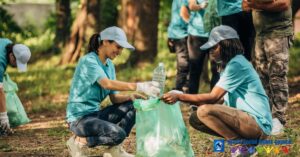As we face the interconnected challenges of environmental degradation and human rights abuses, it’s easy to feel overwhelmed. The magnitude of the issues can seem insurmountable, leading to feelings of isolation and despair. But here’s the good news: we are not alone in this fight. In fact, the very key to overcoming these challenges lies in fostering partnerships and collaborations.
Imagine a world where like-minded organizations, governments, and communities join hands, forming a tapestry of strength and shared purpose. Each thread, representing a different entity, brings its unique skills, resources, and perspectives to the table. Together, they weave a powerful force for change, tackling complex issues with innovative solutions that would be impossible to achieve alone.
Why collaboration is crucial:
- Synergy of expertise: By combining the knowledge and skills of diverse stakeholders, we gain access to a wider range of solutions and approaches. A scientist collaborating with an indigenous community, for example, can create sustainable development plans that respect traditional practices and environmental needs.
- Shared resources: Collaboration allows us to pool resources, both financial and human, maximizing our impact and reaching wider audiences. A small NGO might not have the funds to launch a nationwide awareness campaign, but partnering with a larger organization can make it possible.
- Increased legitimacy: When diverse voices come together, they amplify each other’s messages and lend greater legitimacy to their cause. Governments are more likely to listen to a united front representing various sectors of society.
- Building trust and understanding: Collaboration fosters cross-cultural and cross-sectoral understanding, breaking down barriers and building trust between different groups. This is crucial for creating lasting solutions that address the root causes of environmental and human rights issues.
Examples of successful collaborations:
- The Clean Air Network: A global network of NGOs and activists working together to advocate for cleaner air policies and emission reduction targets.
- The Climate Action Tracker: An independent scientific analysis that tracks government climate action and its compatibility with the Paris Agreement goals, developed by a consortium of research institutions.
- The Indigenous Land Rights Movement: A worldwide movement of indigenous communities and their allies working to protect their land rights and cultural heritage.
How you can get involved:
- Connect with like-minded organizations: Seek out local or national groups working on issues you care about and offer your skills or resources.
- Support collaborative initiatives: Donate to or volunteer with organizations that bring together diverse stakeholders for a common cause.
- Raise awareness: Spread the word about the importance of collaboration and encourage others to get involved.
A collective call to action:
The challenges we face are daunting, but they are not insurmountable. By joining hands and working together, we can build a better future for all. Let’s use our collective strength to weave a tapestry of hope, resilience, and shared purpose. Let’s be the generation that chooses collaboration over division, and action over despair.
Together, we can rise to the challenge. Together, we can build a world where environmental sustainability and human rights go hand in hand.
Visit worldsocialrightscouncil.com and become a thread in the fabric of change.
Remember, even the smallest thread can make a difference in the grand tapestry of our future. Let’s start weaving together today!




